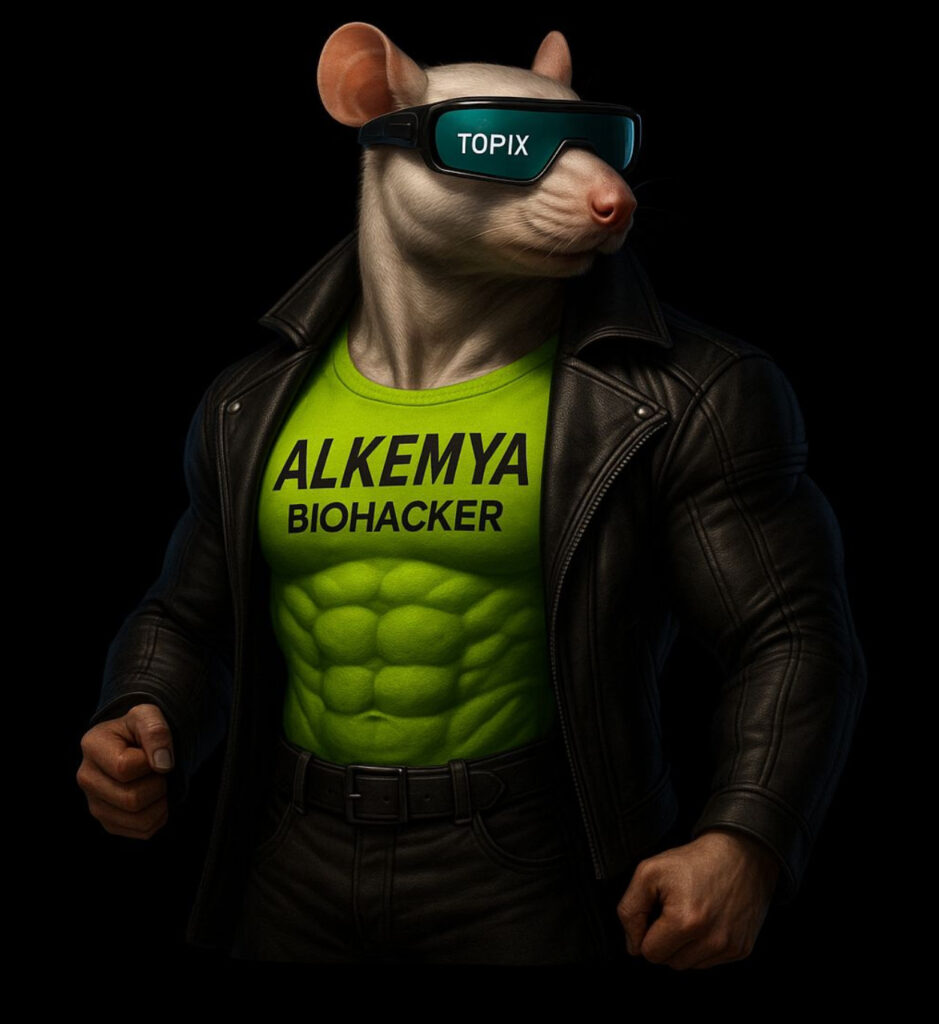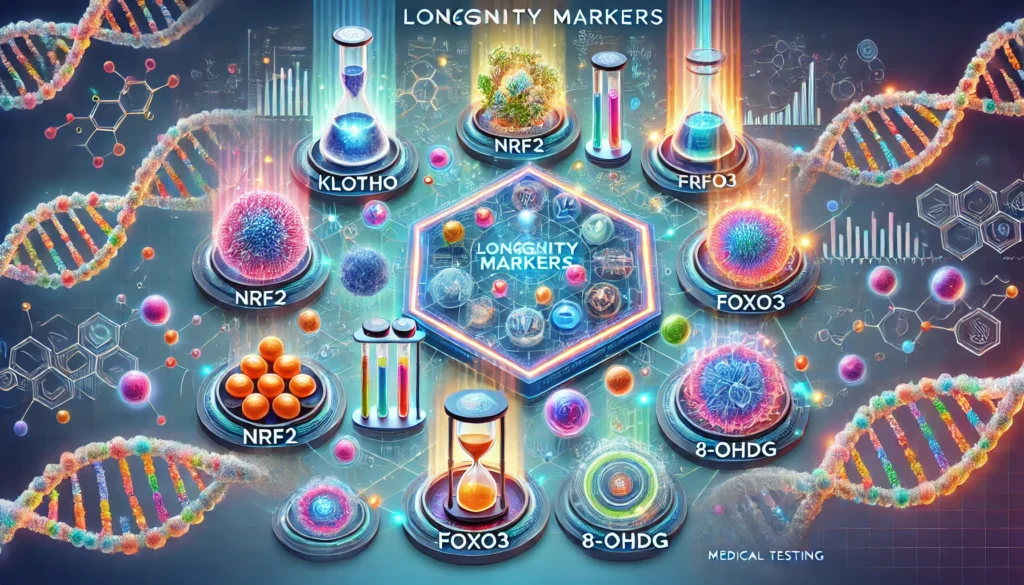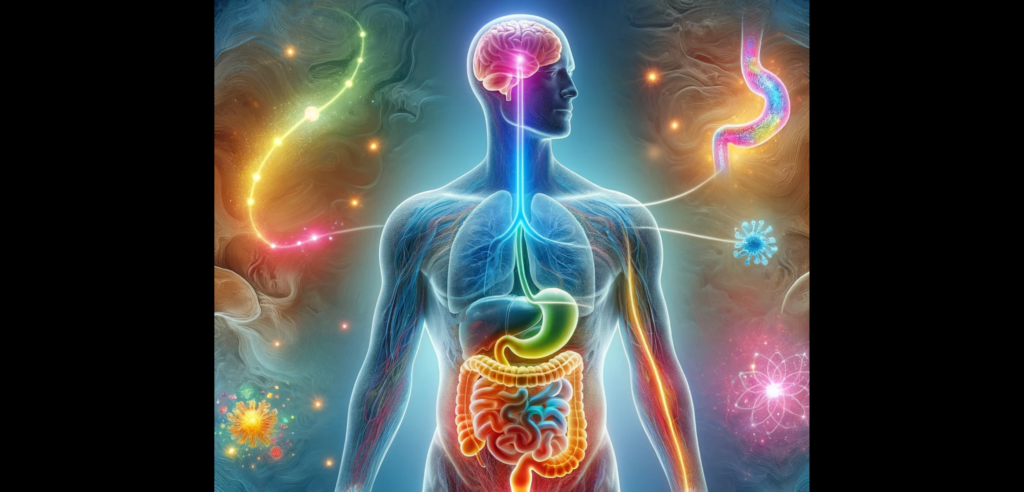In recent years, science has made giant leaps in longevity and anti-aging research. Among the most promising discoveries are peptides, small molecules that are revolutionizing the way we approach aging. But what exactly are peptides, and how can they help us live longer and healthier lives? In this article, we’ll explore how these peptides, including injectable NAD+, act on key biological markers such as Klotho, NRF2, FOXO3, and 8-OHdG, offering an innovative solution to improve our quality of life.
What Are Peptides and Why Are They Important?
Peptides are short chains of amino acids, the building blocks of proteins. Unlike proteins, which can consist of hundreds or thousands of amino acids, peptides are much smaller, with chains ranging from 2 to 50 amino acids. This smaller size makes them particularly effective at communicating with cells and influencing specific biological processes.
Fun Fact: The human body naturally produces peptides to regulate functions such as growth, tissue repair, and immune response. However, as we age, the production of these peptides decreases, contributing to the aging process.
Among the most promising compounds for longevity is NAD+ (nicotinamide adenine dinucleotide), an essential coenzyme—not a peptide—involved in numerous biological processes such as cellular energy production and DNA repair. As we age, NAD+ levels tend to decline, which is associated with a decrease in mitochondrial function and an increase in oxidative stress. Injectable NAD+ represents a highly effective way to deliver this molecule, with the goal of restoring optimal levels and supporting health and longevity. This treatment can help improve energy metabolism, cellular stress response, and cell cycle regulation—all crucial factors in the fight against aging.
The Markers of Longevity: What Are They and Why Are They Important?
Before diving into the world of peptides, it’s essential to understand the biological markers that influence aging. These indicators give us insight into our cellular health and help us identify areas to target in order to slow down time.
Longevity markers are biological indicators that reflect the health of cells and their ability to withstand damage over time.
Among the most important is 8-OHdG, which measures oxidative damage to DNA—a key sign of oxidative stress and the risk of chronic diseases.
FOXO3 regulates cellular repair and protection from stress, playing a fundamental role in longevity and the prevention of age-related decline.
NRF2 is a powerful regulator of antioxidant and anti-inflammatory responses, protecting cells from free radicals and degenerative processes.
Finally, Klotho, often referred to as a “longevity gene,” influences metabolism and tissue protection, improving overall health and slowing aging. Understanding these markers allows us to intervene in a targeted way, using strategies like peptides to enhance cellular regeneration and protection processes.

1. Klotho: The Protein of Youth
Discovered in 1997, the Klotho protein is considered a true “elixir of life.” It regulates calcium and phosphate metabolism, but that’s not all—it’s also involved in numerous cellular processes related to longevity. As we age, Klotho levels decline, and this deficiency has been linked to cardiovascular, kidney, and neurodegenerative diseases. Maintaining high levels of Klotho could be the key to aging more healthily.
Klotho is a protein associated with longevity and the regulation of numerous biological processes essential for health and slowing aging. It acts both as a membrane protein and a soluble protein, influencing key pathways related to metabolism, inflammation, and cellular protection from damage. Adequate levels of Klotho are crucial for maintaining the balance between cellular regeneration and deterioration, ensuring healthier aging and a better quality of life.
One of Klotho’s primary benefits is its ability to modulate calcium and phosphate metabolism, protecting the cardiovascular system and preventing arterial calcification, a leading cause of heart disease. The protein also plays a significant role in kidney protection, reducing the risk of chronic kidney failure and associated damage. In the brain, Klotho has notable neuroprotective effects, enhancing synaptic plasticity and cognitive function while reducing the risk of neurodegenerative diseases like Alzheimer’s and Parkinson’s.
Klotho is closely linked to the regulation of oxidative stress and inflammation, two major factors that accelerate aging and contribute to numerous chronic diseases. Its anti-inflammatory and antioxidant actions help protect tissues from wear and tear, maintaining optimal cellular function. Additionally, the protein positively influences energy metabolism and insulin sensitivity, reducing the risk of metabolic diseases like type 2 diabetes and obesity.
On a broader level, optimal Klotho levels promote slower aging and greater longevity, improving the body’s resilience to environmental and biological stressors. Not only does it help prevent many age-related diseases, but it also enhances quality of life by preserving essential physical and cognitive functions. Its systemic action represents a powerful tool for protecting the body from the effects of aging and promoting lasting health.
Deep Dive: Studies have shown that regular exercise and a diet rich in antioxidants can naturally increase Klotho levels. However, for more targeted results, peptides are emerging as an effective solution.
2. NRF2: The Antioxidant Guardian
NRF2 is a fundamental regulator of our cells’ antioxidant response. When activated, it stimulates the production of enzymes that combat free radicals and protect cells from oxidative stress. In essence, it’s like a superhero defending our body from damage caused by toxins and aging.
NRF2 (Nuclear Factor Erythroid 2-Related Factor 2) is a crucial transcription factor for regulating oxidative stress and the body’s antioxidant response. When activated, NRF2 binds to specific DNA elements known as ARE (Antioxidant Response Elements), stimulating the expression of genes that encode antioxidant enzymes and proteins. This activity protects cells from damage caused by free radicals and other oxidizing agents, supporting overall health and reducing the risk of many diseases.
Optimal activation of NRF2 offers significant health benefits. Its primary role is to enhance the body’s ability to counteract oxidative stress, reducing damage to DNA, proteins, and cell membranes. This process protects against cellular degeneration, slowing aging processes and improving the body’s resilience to external aggressors. NRF2 is also essential for reducing chronic inflammation, as it inhibits pro-inflammatory pathways and promotes the resolution of inflammation, preventing conditions linked to persistent inflammation, such as cardiovascular disease, diabetes, and arthritis.
In the neurological realm, NRF2 plays a protective role, supporting brain health and reducing the risk of neurodegenerative diseases like Alzheimer’s and Parkinson’s, which are closely tied to oxidative damage. On a metabolic level, it improves the body’s ability to manage glucose and lipids, supporting healthy liver function and protecting against the negative effects of an unbalanced diet or toxic substances. Additionally, NRF2 activation strengthens natural defenses against carcinogens, reducing the risk of developing cancer.
Maintaining adequate levels of NRF2 activity is therefore essential for preserving cellular and systemic health. This marker not only promotes longevity but also enhances quality of life by protecting the body from the main risk factors associated with chronic diseases and aging.
Practical Example: Think of NRF2 as a switch that turns on cellular defense systems. Activating it means giving cells the tools to repair and protect themselves.
3. FOXO3: The Longevity Gene
FOXO3 is often called the “longevity gene” because it plays a crucial role in cell survival, DNA repair, and protection against oxidative stress. Individuals with favorable variants of this gene tend to live longer and in better health.
FOXO3 is a gene associated with the regulation of processes crucial for health and longevity and is considered a key marker for cellular well-being and resistance to oxidative stress. Optimal levels of FOXO3 activity are linked to a greater ability of the body to protect itself from cellular damage and support healthy aging. This marker regulates the transcription of genes involved in DNA repair, oxidative stress management, and apoptotic processes, helping to maintain the balance between cell survival and renewal.
Increasing FOXO3 activity can offer numerous health benefits. Effective activation of this gene supports the body’s ability to counteract free radicals, protecting cells from oxidative damage. This process not only reduces the risk of chronic diseases related to inflammation, such as cardiovascular and neurodegenerative diseases, but also helps slow the signs of biological aging, promoting greater longevity. Additionally, FOXO3 is essential for regulating DNA repair and the removal of damaged cells, preventing toxic accumulations that can lead to mutations or diseases like cancer.
From a metabolic perspective, FOXO3 helps improve insulin sensitivity and regulate energy metabolism, protecting against conditions like type 2 diabetes and obesity. In the neurological realm, its role in managing oxidative stress supports brain health, preserving cognitive function and protecting neurons from deterioration. In summary, maintaining optimal FOXO3 activity not only promotes cellular health and reduces the risk of chronic diseases but also represents a strategy for living longer and healthier, with a better quality of life.
Deep Dive: While we can’t change our DNA, we can influence gene expression through healthy lifestyles and targeted therapies, such as the use of peptides.
4. 8-OHdG: The DNA Alarm Signal
8-OHdG is a biomarker that indicates oxidative damage to DNA. Elevated levels of 8-OHdG are a sign of premature aging and increase the risk of chronic diseases like cancer. Lowering 8-OHdG levels can be beneficial for health, as this marker is directly associated with oxidative DNA damage.
Reducing 8-OHdG levels brings numerous health benefits, as it implies less oxidative damage to DNA and greater protection of the body against a wide range of chronic and degenerative diseases. Lower levels of this marker are correlated with a reduced risk of developing serious conditions, such as cancer, where oxidative DNA damage can lead to dangerous mutations. The cardiovascular system also benefits, as oxidative stress contributes to blood vessel deterioration and atherosclerosis, and improving their integrity helps prevent cardiovascular events.
Neurological health benefits as well, since oxidative stress is a key factor in neurodegenerative processes like Alzheimer’s and Parkinson’s. Reducing DNA damage protects neurons and slows cognitive decline. Additionally, decreasing 8-OHdG levels helps slow biological aging processes, as it preserves cellular integrity and improves the body’s ability to regenerate, promoting healthier longevity.
Fertility can also improve, as the quality of sperm and oocytes is negatively affected by oxidative damage. Keeping this marker low helps preserve reproductive function. Furthermore, a significant impact is seen on systemic inflammation: controlling oxidative stress reduces the activation of chronic inflammatory processes that underlie many pathological conditions.
Deep Dive: Oxidative stress is caused by factors like pollution, smoking, poor diet, and even emotional stress. Monitoring and reducing 8-OHdG levels is a crucial step in protecting our long-term health.
How to Monitor Longevity Markers: Lab Test
Before starting any peptide therapy, it’s essential to assess your health status through specific tests. These tests not only give you an idea of where you stand in terms of cellular aging but also allow you to track progress over time. Here’s a practical guide on the markers to check and where you can get these tests done.
1. Klotho
Test: Measurement of serum Klotho levels.
Where to get it: This test is available at specialized laboratories offering advanced analyses, such as those specializing in genomic or functional medicine testing.
Cost: Approximately €150-200.
Tip: If Klotho levels are low, combining peptides like Epitalon or Thymalin with an antioxidant-rich diet and regular exercise may be beneficial.
2. NRF2
Test: Evaluation of NRF2 activity through genetic testing or gene expression analysis.
Where to get it: Specialized genomic testing laboratories.
Cost: Between €200 and €300.
Deep Dive: If NRF2 activity is reduced, peptides like BPC-157 or 5-Amino-1MQ can help reactivate this pathway, enhancing cellular protection.
3. FOXO3
Test: Genetic test to identify FOXO3 gene variants.
Where to get it: You can request this test from labs like 23andMe (with the kit shipped internationally).
Cost: Approximately €100-150.
Reflection: While we can’t change our DNA, we can influence gene expression through healthy lifestyles and targeted therapies, such as peptide use.
4. 8-OHdG
Test: Measurement of 8-OHdG levels in urine or blood.
Where to get it: Available at many clinical laboratories.
Cost: Between €50 and €100.
Tip: If 8-OHdG levels are high, peptides like BPC-157 or GHK-Cu can help reduce oxidative damage and protect DNA.
How Peptides Can Be Real Game Changers
Peptides represent a true turning point in longevity science due to their ability to directly influence key health markers such as 8-OHdG, FOXO3, NRF2, and Klotho. They act as precise messengers that stimulate crucial biological processes, promoting cellular repair and protection.
For example, the peptide GHK-Cu reduces 8-OHdG levels thanks to its potent antioxidant activity, protecting DNA from oxidative damage. Epitalon is known to activate FOXO3, enhancing DNA repair and slowing cellular aging processes.
At the same time, peptides like Thymosin Beta-4 boost NRF2, stimulating the production of antioxidant enzymes that reduce systemic oxidative stress, while BPC-157 promotes increased Klotho levels, protecting tissues and promoting longevity. These peptides work synergistically, offering an innovative and targeted approach to improving health and extending life.
Peptides to Boost Klotho
1. Epitalon:
This peptide is known for stimulating the production of telomerase, an enzyme that protects telomeres (the ends of chromosomes). Studies have shown that Epitalon can increase Klotho expression, prolonging cellular life and improving immune function.
Personal Experience: A friend who tried Epitalon reported feeling more energetic and noticed improved sleep quality.
2. CJC-1295 with DAC:
This peptide stimulates the release of growth hormone (GH), which in turn positively affects Klotho. Benefits include better tissue regeneration and sharper cognitive function.
Fun Fact: Many athletes use it to speed up recovery after intense workouts.
3. Thymalin:
This peptide, derived from the thymus, is known for its regenerative effects on the immune system. Thymalin helps restore the function of immune cells, which tend to decline with age, and indirectly supports Klotho levels.
Benefit: It improves resistance to infections and reduces chronic inflammation.
Peptides to Activate NRF2
1. BPC-157:
Known for its anti-inflammatory and regenerative properties, BPC-157 reduces oxidative stress and supports NRF2 activation.
Practical Example: It’s often used to accelerate the healing of muscle or joint injuries.
2. SS-31:
This peptide acts on mitochondria, improving their function and reducing oxidative damage. Additionally, it activates NRF2 for enhanced cellular protection.
Benefit: It helps prevent age-related cognitive decline.
3. 5-Amino-1MQ:
This peptide is an inhibitor of the NNMT enzyme, which plays a role in energy metabolism. By reducing NNMT activity, 5-Amino-1MQ increases NAD+ levels, a crucial molecule for NRF2 activation and cellular protection.
Fun Fact: It’s particularly effective in combating fatigue and improving vitality.
Peptides to Support FOXO3
1. Epitalon:
In addition to boosting Klotho, Epitalon directly influences FOXO3, increasing cellular resistance to oxidative stress and improving DNA repair.
2. Humanin:
A mitochondrial peptide that protects cells from apoptosis (programmed cell death) and positively regulates FOXO3.
Fun Fact: It has been studied for its potential in preventing neurodegenerative diseases like Alzheimer’s.
3. Vilon:
This peptide, known for its rejuvenating effects, stimulates cellular regeneration and supports FOXO3 activity.
Benefit: It enhances immune function and reduces signs of skin aging.
Peptides to Reduce 8-OHdG
1. BPC-157:
In addition to its regenerative effects, BPC-157 reduces oxidative DNA damage, lowering 8-OHdG levels.
2. SS-31:
This peptide protects mitochondria and improves DNA integrity, reducing markers of oxidative stress.
3. GHK-Cu:
Known for its antioxidant properties, GHK-Cu promotes DNA repair and enhances skin quality.
Injectable NAD+: The Molecule of Cellular Energy
Injectable NAD+ is one of the most powerful molecules for anti-aging. It acts directly on mitochondria, improving cellular energy production and supporting DNA repair. Here’s how it works:
Mechanism: NAD+ is a crucial coenzyme for ATP production (cellular energy) and the activation of enzymes like sirtuins, which protect cells from oxidative stress.
Benefits: It boosts cellular energy, reduces fatigue, enhances cognitive function, and supports DNA repair.
Administration: Injectable NAD+ is delivered intravenously or intramuscularly, ensuring rapid and effective absorption.
Practical Example: Many patients who have used injectable NAD+ report increased energy, improved mental clarity, and a reduction in signs of aging.
A Personalized Strategy for Longevity
Integrating peptides into your anti-aging routine requires a personalized approach. Here are some combinations that might suit your needs, with injectable NAD+ included as a key part of the protocols:
1. Epitalon + SS-31: Protect Telomeres and Improve Mitochondrial Function
- Epitalon: Stimulates telomerase production, protecting telomeres and increasing Klotho expression.
- SS-31: Improves mitochondrial function, reduces oxidative damage, and activates NRF2.
- Injectable NAD+: Boosts cellular energy and supports DNA repair.
- Synergy: This combination protects DNA, enhances cellular energy, and supports longevity.
Practical Example: Ideal for those looking to improve cellular vitality and reduce signs of skin aging.
2. BPC-157 + GHK-Cu: Regenerate Tissues and Reduce Oxidative Damage
- BPC-157: Promotes tissue regeneration and reduces oxidative stress, supporting NRF2.
- GHK-Cu: Encourages DNA repair and improves skin quality, reducing 8-OHdG levels.
- Injectable NAD+: Boosts cellular energy and supports DNA repair.
- Synergy: This combination is perfect for those seeking younger-looking skin and improved wound healing.
Practical Example: Recommended for athletes or individuals with muscle or joint injuries.
3. CJC-1295 with Ipamorelin: Balance Hormones and Stimulate Cellular Regeneration
- CJC-1295 with Ipamorelin: Stimulates growth hormone (GH) release, improving cellular regeneration and supporting FOXO3.
- Injectable NAD+: Boosts cellular energy and supports DNA repair.
- Synergy: This combination is ideal for those looking to improve muscle mass, cognitive function, and hormonal balance.
Practical Example: Suitable for individuals over 40 seeking to counteract age-related hormonal decline.
4. Thymalin + Vilon: Strengthen the Immune System and Support Cellular Regeneration
- Thymalin: Restores immune function and indirectly supports Klotho levels.
- Vilon: Stimulates cellular regeneration and supports FOXO3 activity.
- Injectable NAD+: Boosts cellular energy and supports DNA repair.
- Synergy: This combination is perfect for those looking to strengthen their immune system and reduce chronic inflammation.
Practical Example: Ideal for individuals with a weak immune system or chronic inflammation.
5. 5-Amino-1MQ + Epitalon: Increase NAD+ Levels and Improve Cellular Vitality
- 5-Amino-1MQ: Inhibits the NNMT enzyme, increasing NAD+ levels and improving mitochondrial function.
- Epitalon: Protects telomeres and increases Klotho expression, supporting cellular longevity.
- Injectable NAD+: Boosts cellular energy and supports DNA repair.
- Synergy: This combination is ideal for those looking to increase cellular energy, reduce fatigue, and improve overall vitality.
Practical Example: Recommended for those seeking a powerful anti-aging effect and a boost in energy levels.
Supplements That Work Synergistically with Peptides
In addition to peptides, certain supplements can be combined to maximize benefits:
- Glutathione: A powerful antioxidant that supports NRF2 and reduces oxidative stress.
- Pterostilbene: An activator of NRF2 and FOXO3, with anti-inflammatory and anti-aging effects.
Risks and Precautions: What to Know Before Starting
While peptides offer enormous potential benefits, it’s crucial to approach their use with caution. Here are some risks and precautions to consider:
- Side Effects: Some peptides may cause side effects such as nausea, fatigue, or skin reactions. It’s important to start with low doses and monitor your body’s response.
- Product Quality: Not all peptides are created equal. Ensure you purchase from reputable, certified suppliers to avoid contamination or low-quality products.
- Medical Supervision: Peptide use should be supervised by a specialized doctor, especially if you have pre-existing medical conditions or are taking other medications.
- Regular Monitoring: Perform regular blood tests and other evaluations to monitor biological markers and assess the effectiveness of the therapy.
Conclusion: The Future of Longevity is Here
Peptides represent one of the most exciting frontiers in anti-aging science. Thanks to their ability to influence biological markers such as Klotho, NRF2, FOXO3, and 8-OHdG, as well as increase NAD+ levels, they offer a scientifically validated solution for slowing aging and improving quality of life. With the right approach, living longer and healthier is no longer a dream but a reality within everyone’s reach.












